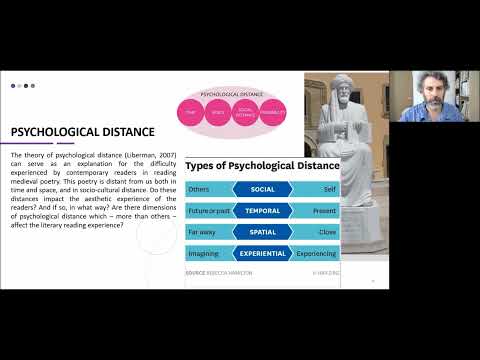 Speaker : Amir Harash
Speaker : Amir Harash
 Affiliation : Tel Aviv University, Israel
Affiliation : Tel Aviv University, Israel
Title : Who likes medieval Hebrew poetry?
Abstract : Our study aimed at explaining why Medieval Hebrew poetry, which excelled in stylistic and linguistic innovation, has failed to reach contemporary readers – is it because of the old Hebrew, or are other psychological aspects at play? We have thus conducted an internet-based experiment, in which 227 volunteers read four medieval poems and answered questions regarding aesthetic appreciation, their understanding of the text, and their psychological distance from the text and its authors. Our findings highlight the importance of psychological distance in reading medieval Hebrew poetry and especially the importance of ‘personal distance’, that is, the distance the reader feels from the poet.

 Long abstract
Long abstract
In medieval times, Hebrew poetry reached an unprecedented peak during the Golden Age of Jewish culture in Spain (711-1031 AD). Medieval Hebrew poetry excelled in stylistic and linguistic innovation that inspired readers and poets in the centuries that followed. The poems dealt with diverse topics, both religious and secular: courtship, lust, wine drinking, philosophy and grim contemplation. Unfortunately, in recent decades this valuable treasure of Hebrew culture has struggled to find way to its potential readers. Partly, this is because the poems were written in old Hebrew that readers today find hard to understand. But also because the cultural changes that took place in the last millennium, as well as shifts in stylistic norms, contribute to a feeling of distance from the texts and their authors.
In this study our aim is to better understand the role that the comprehension and psychological distance play. Following that, our next step would be to suggest ways to help contemporary readers approach this kind of poetry, and hopefully help bridge the gap between ancient texts and modern audiences.
Procedure and methods
In an internet-based experiment, 227 volunteers (65% female) reached by social media, read four medieval poems. Two of lust and two of grim contemplation written by three medieval poets: Solomon ibn Gabirol, Moses ibn Ezra and Samuel ibn Naghrillah (also known as Samuel HaNagid). Participants answered several general questions regarding their reading habits and 10 items regarding each poem, on a 5-point Likert scale. The questionnaire contained 4 aesthetic items (liking, being moved, deep meaning and amusement), 2 items of subjective understanding (hard to understand, unfamiliar vocabulary) and 4 items regarding psychological distance (temporal distance, temporal proximity, cultural distance and personal distance).
Main findings
The poems dealing with grim contemplation received better scores on the aesthetic scales: readers liked them better, were more moved by them, and found deeper meaning in them, and this despite them being rated as harder to understand than the poems expressing lust. On a regression model the items regarding understanding did not show a significant connection to the aesthetic items, while items regarding psychological distance did. Aesthetic items were especially correlated to the item about personal distance: “I feel closeness to the person who wrote this poem”. This item was found to be very central and influential, with a beta value of 0.61 to the aesthetic items.
Conclusions
These findings highlight the importance of psychological distance in reading medieval Hebrew poetry and perhaps in reading difficult ancient poetry in general. In particular, the study reveals the importance of ‘personal distance’, that is, the distance the reader feels from the poet. The finding that ‘understanding’ wasn’t significantly correlated with aesthetic indices was surprising and perhaps is related to the specific genre we are dealing with here. Medieval poetry can be difficult to understand, which may lead to reading strategies in which aesthetic appreciation is not based heavily on comprehension but rather on other factors. Hence, it seems that if we wish to help readers connect to this kind of poetry it may be pertinent to try and bridge the personal gap, and make the reader feel closeness to the poet, than to explain the poems’ meaning or vocabulary. In further research we wish to manipulate the presentation of the poems to affect both the understanding and psychological distance, to see if a causal relationship between these factors and aesthetic appreciation can be established.

